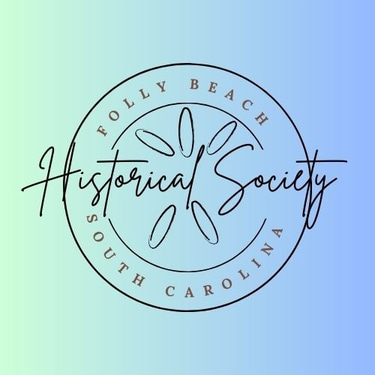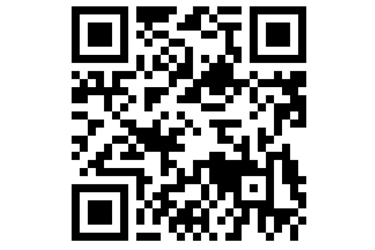Surfing on the Edge
By Richard L. Beck
Foster Folsom was 16 years old in 1963 spending a typical summer’s day on the Plaza boardwalk, talking to friends and looking at girls, when he saw something that he had never seen before. He and some friends were standing near the eastern end of the board walk looking down on one of the Smoak’s Float Stands when they noticed a man with a Hobie surfboard. He was casually rubbing candle wax onto the board. What does he think he’s doing? (Most probably Sarge Bowman)
Foster and his friends were aware of surfing. The movie Gidget (girl midget) starring Sandra Dee and James Darren had introduced the rest of America to California surfing in 1959, but the phenomena had not reached Folly partly because no one believed Folly had the waves to make surfing possible. Foster trotted down stairs to let the man know it wasn’t possible to surf here and the man kindly said, “Well, let’s just see about that”. Foster watched as he paddled his board into the two-foot surf next to the pier and caught a nice wave for a ride back to shore. Foster’s life would never be the same. From that moment on, his life became “surf dependent”.
Surfing was bought to Folly by airmen from the west coast who were stationed in Charleston with their kids – all about the local boy’s ages, but much more worldly. “Sarge” Bowman is an airman often credited with teaching the locals the fundamentals of surfing. Airmen were the beginning of the creation of surfing at Folly.
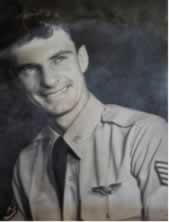

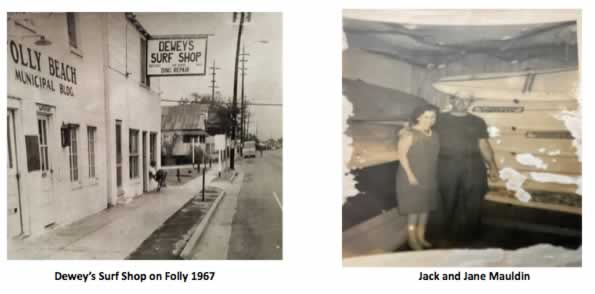

By the beginning of the 1963 hurricane season, Pat Thomas, the first women to surf on Folly, bought a board with the money she had made by working at Smoak’s Float Stands (there were three). Pat let Foster ride it out onto the majestic waves that an offshore hurricane brought to Folly. From that moment on, every decision Foster ever made about his direction in life was based on whether or not he was going to be close the ocean and surfing. One of the airmen Allen Barnett sold Foster his first surfboard – Foster had saved the money he made by setting pins all summer at McKevlin’s Bowling Alley – and by January he surfed the first wave on his own surfboard and was hooked.
When you talk to any of the other men and women that were part of the beginnings of surfing at Folly, you’ll hear a very similar story. It didn’t take long for the other locals, Ted McKevlin, Chip Yarnell, George Steel, Bo Stallings, Ray Holliday, Carl Beckman, Dean Monk, Phil Przyborowski, Dewey Mauldin, Frank Davis, Philip (Bugsy) Chevrier, Jackie Peters, Kim Nutt, Ricky Koger, Eddie Andrews, Howie Davis, Nancy Polk, Lindey Corely, Ronnie Shepard, Michael Urrichio, Brenda Tucker, Harry Erickson, Bill Hood, Tommy Bolus, Pat Thomas, and Rex Whitcomb, and Donny Smith, to be hooked.
In the beginning, surfboards were so rare that the locals often had to share a single board, standing in line for their turn and – whether they were successful or not – they took their best shot and returned to the end of the line 4 or 5 deep and waited for their next try.
The demand for surfboards, albeit small, had arrived and cheap boards “Pop Outs” began to appear at Edward’s 5 and 10 Cent stores, Woolworths and GEX (an early version of Sam’s Club). But…serious riders wanted serious boards.
Denis McKevlin and his son Ted opened the first McKevlin shop in May of 1965.
In the summer of 1965, a couple of older guys from Jacksonville, Rick Hanza, and Steve ? arrived and opened a shop in what used to be River’s Grocery next to City Hall (the Sshark’s head marks the building today). Interestingly enough, they called it Ocean Surf Shop. They brought surfboards that were being made in Florida. The shop lasted about 4 months. From 1966 – 1977, the building that housed Rick Hanza’s Ocean Surf Shop would house Dewey’s Surf shop, Dewey (David Mauldin) with his mom and dad, Jane and Jack, didn’t just sell surfboards. Jane also sold handsewn surfing shorts that she named Hurricane Baggies and made hamburgers for her family of surfers. The shop also sponsored a surfing team. Jane Mauldin was known as the mother of surfing on Folly Beach.
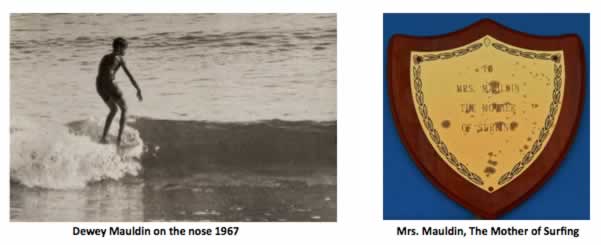

Not everyone that surfed had a car so the Mauldin Family opened the Surf Shack in 1968 as a place where you could rent a spot to store your board. It was run by Brad Bowman, Eddie Andrews, and George Steel. Henry tells me it was located in the northern portion of the space occupied by the pool tables at the Sand Dollar today.
In 1971, Henry Edwards opened Eastern Surf Shop on Center Street in what had been McNally’s bar at the SW corner of Center and Ashley Ave. His shop burned due to a chimney fire. He moved briefly to the old Tommy and Kitty Winges’ News Stand. It lasted less than a year. When it closed, Donny Smith and his mom Jo Ann took it over, renamed it the Wave Machine and then moved it closer to the beach in the building currently diagonal to City Hall at the SE corner of Center and E. Cooper with singer, song writer, and surfer David Owens as asst. manager. The shop was known for having a beach sand floor. The shop closed in 1974. It had some nice successes with its team comprised of Glenn Tanner, Gregg Elliot, Al Logan and Eddie Hollingsworth. They sold Nomad, Australian, and Challenger boards. Donny was state champion in 1974 and a mentor to many.
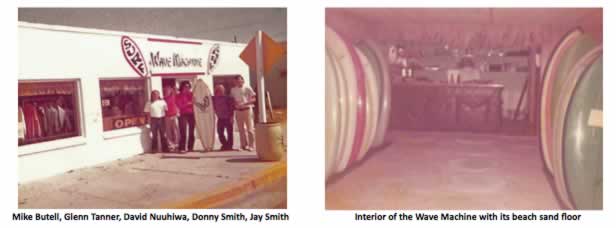

Ricky Koger started a surf shop in 1977 in a 15 x 15 space that he rented from Mrs. Polk in the building that used to be the old bingo parlor (Bounty Bar). In 1978, after Dewey’s Surf Shop faded, Ricky rented the building and created the Natural Arts Surf Shop and sold Natural Arts surfboards in association with the board’s creators, Pete Dooley and Scott Bugsby.
Natural Arts Surf Shop had a four-year run. The shop sponsored several teams that did well at regional events. Below is a 1979 Richard Green photo of some of the patrons of the Natural Arts shop.
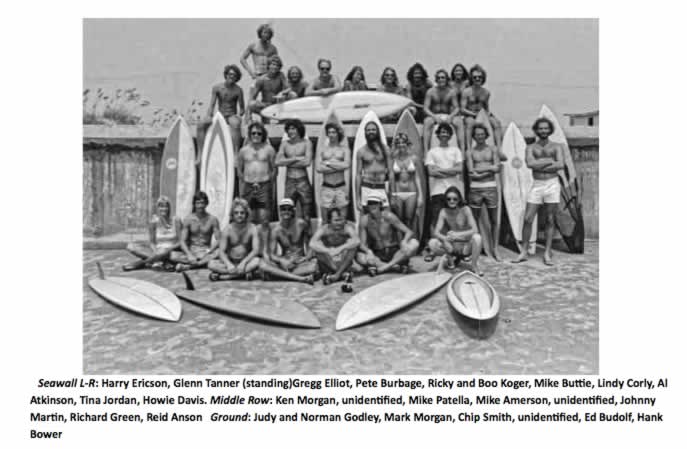

Ownership of the store passed for a short time to the creators of the Natural Art surfboard line until 1984 when Bill Perry and Bettie Sue Cowsert bought the building from Mr. Stringer and the business from Pete Dooley and Scott Bugsby. They renamed the business Ocean Surf Shop for the second and final time. Bill and Bettie Sue and their friend Bill Bartlett created and copywrited the moniker that will forever identify Folly Beach as “The Edge of America”. The shop later moved to 31 Center Street.
Ocean Surf Shop, still located at 31 Center Street, is now under the ownership of Bates Hagood, who along with his wife Lesa Parrott are celebrating the 40 plus years of Ocean Sport as Folly’s only surf shop other than McKevlin’s to survive since its 1984 beginning. Bates is often called on to defend the copyrighted moniker that defines Folly.
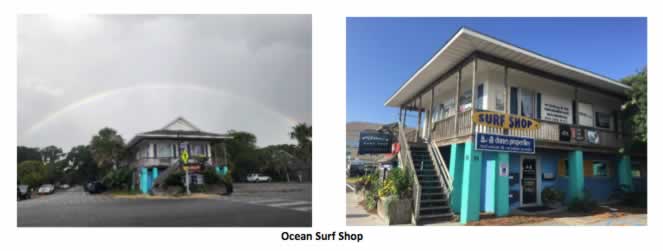

McKevlin’s Surf Shop is the oldest surviving surf shop on Folly and as such is worthy of special note. Ted McKevlin was the front man for Dennis McKevlin’s Surf Shop that opened in May of 1965. The shop was housed in a tiny store room on the side of the bowling alley with a door that opened onto East Artic. The room had been used as a temporary jail cell in the 1940s. By 1967 the surf shop had moved to the front of the remodeled Bowling alley. In 1980 it moved to its present location at 8 Center Street.
Dennis McKevlin or “Mr. Mac” as he was affectionately called was, from the beginning, a fierce advocate for surfing. The Township of Folly began to actively hinder the sport in June of 1965.
Irascible and irrepressible, his love for the surfers and the sport was evident at all times. Everyone knew better than to get between Mr. Mac and the growth of surfing. While he was alive, Mr. Mac WAS surfing on Folly. McKevlins would prove to be the most durable surf shop on Folly. Early on, “Mr. Mac” would give surfboards to the locals to create the first surfing team on Folly and further promote the sport. After Mr. Mac’s death, Ted’s younger brother Tim McKevlin took over the operation of the shop and has made McKevlin’s Surf Shop one of the oldest, if not THE oldest, family-owned surf shops on the east coast, celebrating its 60th anniversary in May of 2025.
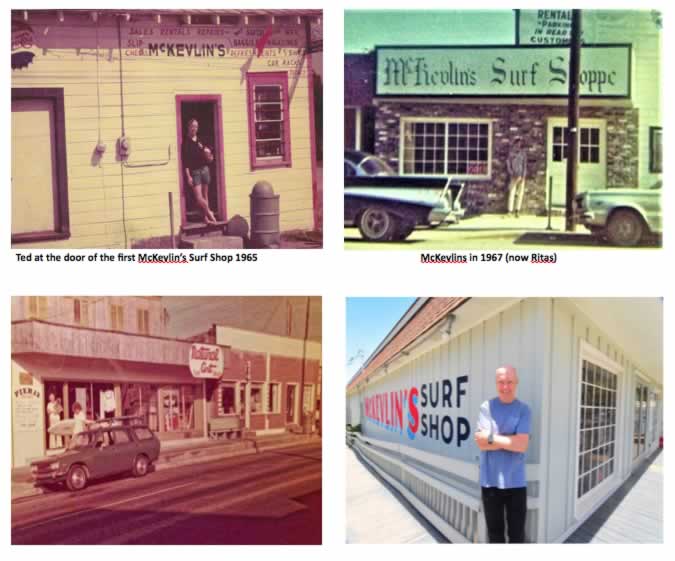

John "Sarge" Bowman
Ted McKevlin - McKevlin Surf Shop 2025
Ricky Roger's first Natural Art Surf
Shop 1977 in the old Bingo Parlor

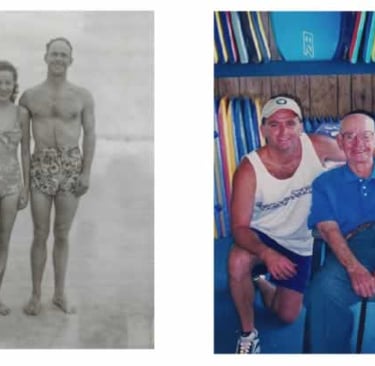
D.J. and Beverly McKevlin, Daytona 1946
"Mr. Mac" and Alton Wiggins, 1990
